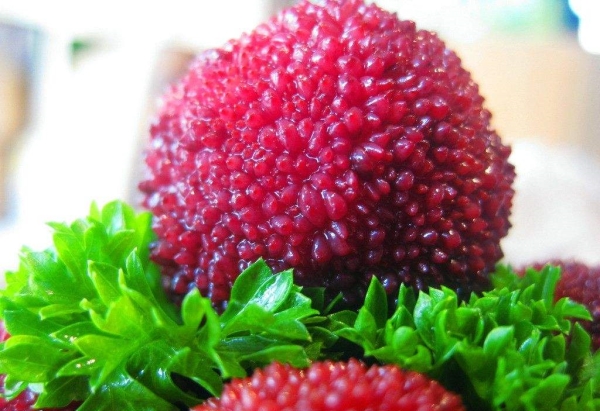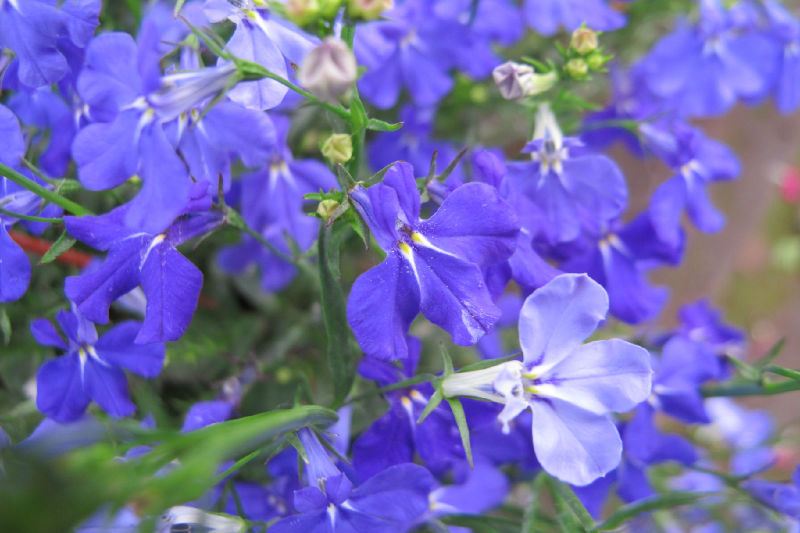Maintenance methods of Waxberry
Improve the drainage system
The picking period of red bayberry is often high temperature and rainy season in summer, and there is often short-term rainstorm or even torrential rain, which scour the roots of fruit trees, resulting in the loss of base fertilizer, exposure of fruit roots and affecting the normal growth of fruit trees, so we should strengthen orchard management and improve the drainage system.

Control of diseases and insect pests
In general, high temperature and humidity weather will lead to the occurrence of all kinds of diseases and insect pests, especially before and after fruit ripening, fruit flies and other harm to mature fruit, affect the quality, we should pay attention to monitoring and control. In prevention and control, it is mainly entrapment and killing, and do not use pesticides.
Culture methods and matters needing attention of Myrica rubra
Latin name Myrica rubra (Lour.) S. Et Zucc.
Don't call it Shengsheng Mei, Bai Ti Mei, Shu Mei.
The plant kingdom.
Phylum angiosperm
Magnolia (dicotyledonous class)
Subclass primitive perianth subclass
Myrica
Myricaceae
Belonging to the genus Myrica
Species of red bayberry (M. rubra)
Distribution area East China and Hunan, Guangdong, Guangxi, Guizhou and other places
Environmental distribution in the slopes or valleys of low mountains and hills
Ecological habits of terrestrial plants
Life form evergreen tree
Rizhao shady fruit trees
Moisture over 1000 mm
Average temperature 15: 21 ℃
Soil likes acid soil
Altitude 125-1500 meters above sea level
Edible value raw food, can be processed into dried bayberry, sauce, candied fruit
Medicinal value to quench thirst, invigorate fluid, aid digestion and other functions
An additive for industrial value cosmetics that can be used to make wine.
Special purpose used as Auburn dye, astringent in medicine
Toxic and non-toxic
The symbolic meaning is called "green enterprise" and "cash cow".
Country of origin Yuyao, Zhejiang, China
Myrica rubra belongs to small trees or shrubs of the genus Myrica of Myricaceae, also known as Shengsheng plum, white plum and tree plum, which have high medicinal and edible value, and are distributed in East China and Hunan, Guangdong, Guangxi, Guizhou and other areas. Myrica rubra originated in Yuyao, Zhejiang Province, China. The pollen of Myrica was found during the excavation of the Neolithic Hemudu site in Yuyao in 1973, indicating that bayberry grew in this area more than 7000 years ago. There are more than 50 species of this genus, of which bayberry, white bayberry, hairy bayberry, green bayberry and dwarf bayberry are known in China. Red bayberry has luxuriant branches, round crown and numerous red fruits in early summer. it is an excellent tree species combined with landscaping. It is appropriate to plant alone, in clusters in lawns, courtyards, or by the side of the road, and it is also ideal to use close planting to separate spaces or shelter them. Economic use fruit taste sour and sweet moderate, not only can be eaten directly, but also can be processed into dried bayberry, sauce, candied fruit, etc., but also can make wine, has the functions of relieving thirst, invigorating fluid, aiding digestion and so on.
1. Morphological characteristics.
Tree trunk
Evergreen trees, up to 15 m tall and more than 60 cm DBH; bark gray, longitudinally lobed when old; crown globose. Branchlets and buds glabrous, lenticels usually few but inconspicuous, only round and peltate glands when young.
Leaf
Leaves leathery, glabrous, surviving until 2 years deciduous, often concentrated in the upper part of branchlets; those born on germinating strips are long elliptic or cuneate-lanceolate, more than 16 cm long, apex acuminate or acute, sparsely sharply serrated above middle margin, often entire below middle, base cuneate Those born on pregnant branches are cuneate-Obovate or long elliptic-Obovate, 5-14 cm long and 1-4 cm wide, apex obtuse or mucronate to acute, base cuneate, entire or occasionally with a few sharp serrations above middle, dark green above, glossy, light green below, glabrous, only covered with sparse golden glands, midrib and lateral veins prominent on both sides after drying, more elevated below Petiole 2-10 mm long.
Stamens
Flowers dioecious. Male inflorescences single or several clustered in leaf axils, Terete, 1-3 cm long, usually unbranched in a single spike, sparsely with inconspicuous extremely short branches at base, basal bracts sterile, pregnant bracts suborbicular, entire, abaxially glabrous, covered only with glands, ca. 1 mm, with 1 male flower in each bract axil. Male flowers with 2-4 ovate bracteoles and 4-6 stamens; anthers elliptic, dark red, glabrous. Female inflorescences are often solitary in leaf axils, shorter and thinner than male inflorescences, 5-15 mm long. Bracts are similar to those of male flowers, closely connected into an imbricate arrangement, with 1 female flower in each axil. Female flowers usually
With 4 ovate bracteoles; ovary ovate, extremely small, glabrous, apical very short style and 2 bright red slender stigmas, with papillary raised stigmas on the inside. Only 1 (sparse 2) female flower at the top of each female inflorescence can develop into fruit.
Fruit
Drupe globose, with papillary protuberance on the outside, 1-1.5 cm in diameter, about 3 cm in diameter, exocarp fleshy, juicy and resinous, sour and sweet, crimson or purplish red when ripe; stone is often broadly oval or ovoid, slightly compressed, 1-1.5 cm long and 1-1.2 cm wide, endocarp extremely hard and woody. It blossoms in April and the fruit ripens from June to July.
2. Growth environment
Red bayberry, acid-loving soil, is native to hillslopes or valley forests of temperate and subtropical humid climates in China. It is mainly distributed in the south of the Yangtze River basin and north of Hainan Island, that is, between 20 and 31 degrees north latitude. Similar to citrus, loquat, tea tree, bamboo, etc., but its cold resistance is stronger than citrus, loquat.
3. Distribution range
Bayberry is distributed in Yunnan, Guizhou, Zhejiang, Jiangsu, Fujian, Guangdong, Hunan, Guangxi, Jiangxi, Sichuan, Anhui, Taiwan and other provinces in China. A small amount of bayberry is cultivated in foreign countries, such as Japan and South Korea, and in Southeast Asian countries. such as India, Myanmar, Vietnam, the Philippines and other countries.
What are the advantages of red bayberry? an analysis of the efficacy and function of red bayberry
I remember when I was in primary school, there was a text called "I love the bayberry in my hometown", in which it was written that the bayberry was round, the same size as longan, and covered with small thorns. When the bayberry is gradually ripe, the thorn is also gradually soft and flat. Pick one and put it in your mouth, and the tip of the tongue touches the smooth thorn of red bayberry, making you feel delicate and soft. It can be seen that red bayberry is indeed a favorite fruit. Red bayberry is rich in Jiangsu and Zhejiang provinces when it is ripe, and it is one of the specialty fruits in China. It enjoys the reputation of "the first doubt is worth a daughter". The red bayberry fruit has bright color, many juices, sweet and sour palatability and high nutritional value. The dietotherapy effect of red bayberry is sweet and sour, warm and non-toxic, returning to the lung and stomach meridian; it has the effects of invigorating the body to stop thirst, astringent intestines and diarrhea, and stomach to stop vomiting, digestion and diuresis; it is used for dizziness and muscle and joint pain caused by overwork: red bayberry wine is 30g / 60g, take it once in the morning and evening. Precautions Food Xiangke must be known to everyone, the same is true of red bayberry, the Tang Dynasty Meng Yi: "Waxberry must not eat too much, very can damage teeth and tendons, avoid eating with raw onions." Red bayberry bogey is eaten with raw onions and duck meat. After eating bayberry, you should gargle or brush your teeth in time to avoid damage to the teeth. Bayberry has a certain stimulating effect on the gastric mucosa, so patients with peptic ulcer should eat carefully, those who get angry should not eat more, and people with diabetes should avoid eating. The ornamental value above is a brief introduction to red bayber. in addition, the garden ornamental value of red bayberry is also very high, with ancient trunks, luxuriant branches and luxuriant leaves, just like natural tree stump bonsai. The Summer Solstice red bayberry is full of red mountains, bright and pleasing to the eyes, hidden in the lakes and mountains, becoming a gorgeous scenic line of Dongting Mountain. More information: | what does white rose mean | what plant is protected against computer radiation | geranium | cultivation methods and precautions of azaleas | Golden Cymbidium | | Lavender florescence | Indoor foliage plants | Parthenocissus | Lilium foliage | efficacy and function of mint | Culture method of mimosa | | how to raise succulent plants | Osmanthus | efficacy and function of gynostemma pentaphyllum | hand-made roses | Efficacy and function of Honeysuckle | Kumquat |
- Prev

Planting techniques of Radix Aucklandiae
Planting techniques of Radix Aucklandiae
- Next

Six times the profit of culture
1. The growth temperature is 15-18 degrees, and then drops to 10-15 degrees. This temperature will make the root system develop well. Liubeili is very sensitive to low temperature. It is best to keep the growth temperature at 15-18 degrees in spring and provide long-day sunshine.
Related
- Fuxing push coffee new agricultural production and marketing class: lack of small-scale processing plants
- Jujube rice field leisure farm deep ploughing Yilan for five years to create a space for organic food and play
- Nongyu Farm-A trial of organic papaya for brave women with advanced technology
- Four points for attention in the prevention and control of diseases and insect pests of edible fungi
- How to add nutrient solution to Edible Fungi
- Is there any good way to control edible fungus mites?
- Open Inoculation Technology of Edible Fungi
- Is there any clever way to use fertilizer for edible fungus in winter?
- What agents are used to kill the pathogens of edible fungi in the mushroom shed?
- Rapid drying of Edible Fungi

